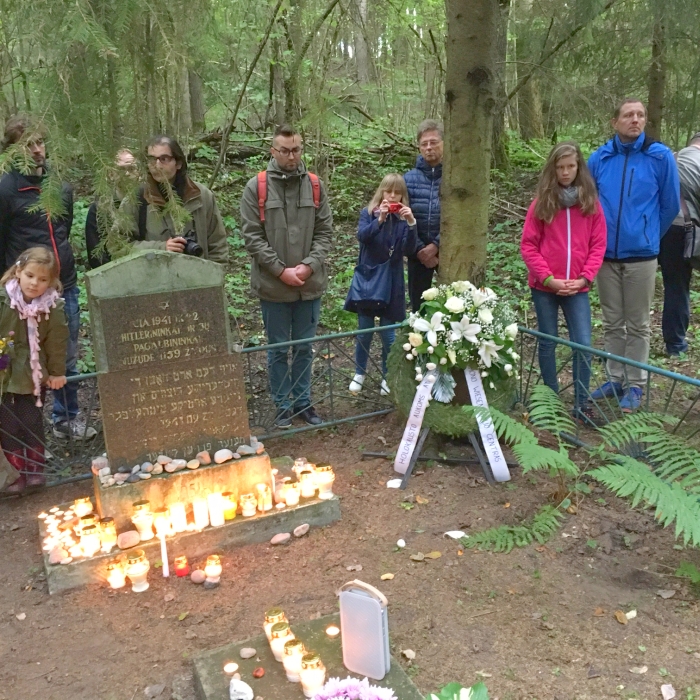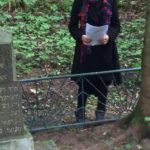
The project is based on the fact that there are 227 Holocaust mass murder sites in Lithuania scattered all across the country.
I had never heard of Vėliučionys, a small village on the outskirts of Vilna (Vilnius) before Lithuanian author Rūta Vanagaitė and I set out in the summer of 2015 to visit sites of Holocaust mass murders for a book we wrote on Lithuanian complicity in Shoa crimes.
Our original list of destinations was compiled based on our biographies.
I chose the birthplaces of my maternal grandparents Samuel and Bertha Sar, and the towns in which they had grown up and studied, as well as the presumed site of the murder of my great-uncle Rabbi Efraim Zar, for whom I am named, his wife and two sons. Rūta chose the places where her grandfather Jonas Vanagas and her aunt’s husband Antanas Stapiulionis had played a role in the murder of Jews.
Toward the end of our research, after we had visited Ponar (Paneriai), the site of the mass murder of the Jews of Vilna, where Efraim Zar and his family almost certainly were killed, we decided that we should visit one more place in the vicinity of Vilna to get a more complete picture of the events in most important center of Lithuanian Jewish life. Rūta read in the Holocaust Atlas of Lithuania, a superb resource for this kind of research, that the mass murder site in Vėliučionys was hard to find, so we thought it might be important to write about it, as an example of numerous such sites which are either unmarked, erroneously marked and/or very difficult to find.
And that was indeed the case in Vėliučionys. We initially traipsed around through thick brush and bramble with no success for almost an hour, during which we found ourselves facing a large garbage dump on the spot where the memorial was supposed to be, but could not find the site. If we had not purely by chance run into a local mushroom-picker who was well acquainted with the area, we most probably would never have found it. In fact, several weeks ago, after we had for that reason chosen Vėliučionys as the site for a memorial ceremony to be held on Lithuania’s Holocaust remembrance day, it took us almost three hours to again find the monument.
We later learned that starting in mid-September 1941, the Jews of Naujoji Vilnia, Rudamina, Šumskas, Mickūnai and Rukainiai were rounded up and brought to the local orphanage, barracks and stables in Vėliučionys, where they were held until September 21-22, 1941, when all 1,159 Jewish men, women and children were murdered nearby on Bald Mountain by Lithuanian volunteer murder squads. In 1951 the Soviet authorities placed a monument there surrounded by a low fence, but virtually no mourners had been there for many years, which made the site a perfect location for a memorial ceremony as part of a new project which Rūta conceived this year entitled “Čia guli musiškiai” (Our People Lie Buried Here).
The project is based on the fact that there are 227 Holocaust mass murder sites in Lithuania scattered all across the country, and in fact, practically any resident of Lithuania can reach such a site in less than an hour. The problem until now, however, has been that since independence in 1991 it has been very rare for the average Lithuanian to show any interest in the victims of the Shoa, even though a highly significant number were murdered by Lithuanians. Part of this was due to the government’s efforts from the very beginning to minimize or hide the role of local collaborators in the murders, and to promote the canard of equivalency between Nazi and Communist crimes.
During the past year, however, things appear to be changing for the better, with increased interest by younger and more educated Lithuanians. The two main milestones in that respect were the appearance of our book, Mūsiškiai, on Lithuanian complicity in Holocaust crimes, which became a best-seller to the consternation of many, primarily older Lithuanians, who continue to view Jews as supporters of the Communist occupations of Lithuania. The second was the August 29 memorial march in Molėtai, which attracted about 3,000 participants, most of whom were Lithuanian. Also important was the impressive support for these initiatives by Lithuania’s leading news portal, www.delfi.lt.
This past Friday, on Lithuania‘s official Holocaust remembrance day, we were able to add another milestone. In response to Rūta’s call on social networks, about 80 Lithuanians of all ages, among them several outstanding local cultural and media figures, came at 5 P.M. to Vėliučionys and marched the almost two kilometers from the manor to the murder site, where a very moving ceremony was held to honor the long-forgotten victims.
In addition, similar ceremonies were held in at least four other locations – Šaukėnai, Naujaneriai, Lazdijai and Vilkaviškis.
We hope that this will be the beginning of a country-wide movement to turn the Jewish victims of the Shoa from nameless outsiders to neighbors and fellow citizens of Lithuania, in short, into mūsiškiai, our people.
The author is the chief Nazi-hunter of the Simon Wiesenthal Center and director of the center’s Israel office and Eastern European affairs. His most recent book co-authored with Rūta Vanagaitė, Mūsiškiai: Kelionė su priešu (Our People; Journey with an Enemy), was published this year by Alma Littera publishing house in Lithuania. His websites are www.operationlastchance.org and www.wiesenthal.com
He can be reached on facebook and twitter at @EZuroff.
Full article here.
![]()
Photos by Efraim Zuroff.





